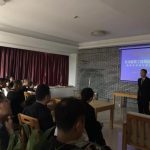The bottom image shows that the OsteoProbe indentation is comparable to naturally occurring irregularities on the bone surface; © UCSB
For people taking glucocorticoids such as prednisone, the increased risk of bone fracture is a well-documented side effect. Used to treat a variety of medical conditions, including autoimmune diseases and allergies, glucocorticoids are known to cause rapid deterioration in bone strength. Scientists explore a new parameter of bone quality that measures strength instead of density.
Until now, doctors have been able to measure bone loss – a process that happens slowly, over time – but have not had the means for gauging actual bone strength. That has changed thanks to a new hand -held instrument developed in the Hansma Lab at UC Santa Barbara. Called the OsteoProbe, the device uses reference point indentation (RPI) to measure mechanical properties of bone at the tissue level.
A new clinical trial, conducted at the Hospital del Mar in Barcelona, Spain, shows that RPI is sensitive enough to reflect changes in cortical bone indentation following treatment with osteoporosis therapies in patients newly exposed to glucocorticoids. Standard measurement techniques were unable to detect bone changes in this patient population. The trial results are reported in the Journal of Bone and Mineral Research.
“This new paper is a real breakthrough because it is the first time it has been possible to do a longitudinal study of bone material properties in patients,” said co-author Paul Hansma, professor emeritus in UCSB’s Department of Physics. “Up until now, medical professionals have been limited to doing bone mineral density studies, which can take a year or more to show bone changes.”
According to Hansma, measuring bone mineral density (BMD) using today’s standard, dual X-ray absorptiometry (DXA) provides only a partial picture. “DXA measures density, which sounds like a material property but is not,” he said. “DXA measures how much calcium bone contains but provides no information about bone quality, and it is not just how much bone you have that is important, it’s how good that bone is.”The OsteoProbe works similarly to a center punch – the tool that makes a slight indentation on a surface to indicate the correct placement of a nail. It sets a localized reference point at the bone’s surface that enables precise indentation measurements of bone strength. It was developed by Hansma and colleagues Connor Randall and Dan Bridges, staff research associate and development assistant engineer, respectively, in UCSB’s Department of Physics.
The OsteoProbe measures the bone material strength index (BMSi), which in previously published papers has been shown to be a valuable predictor of bone fracture risk. The index values are similar to percentage scores on an exam. A BMSi of 90 or greater is excellent, 80 to 90 good, 70 to 80 fair, 60 to 70 poor and below 60 very poor.
A study conducted at the Mayo Clinic in Rochester, Minnesota, demonstrated the device’s ability to successfully detect bone quality deterioration in diabetic patients, independent of BMD. In another study conducted at Leiden University in the Netherlands, the tool successfully distinguished between patients with and without fracture, not only in patients with osteoporosis but also in those with osteopenia, the precursor to osteoporosis.
“Bone fracture is becoming more and more of a serious problem as people live longer,” Hansma said. “It is exciting that it’s now possible to measure BMSi in living patients and hopefully this can guide physicians in the future in choosing appropriate therapies to prevent bone fracture, especially in elderly people.”



